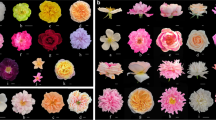Abstract
An autopolyploid series comprising 2x, 3x and 4x was obtained by colchicining the diploid speciesA. ovatum Lag. The autotriploid, used as seed and pollen parent, was back-crossed to diploid and tetraploid. No significant overall difference was observed in fertility, but there was a tendency for particular pair crosses to the diploid as female parent to show higher levels of seed-setting. This may be associated with the relatively large proportion of haploid pollen that functions when the triploid is used as the male parent.
The effectiveness, in part, of the freely liberated pollen of autotriploidAnthoxanthum in producing progeny, contrasts with the total failure of manually liberated allotriploidDactylis pollen. Triploid sterility may well relate to degree of hybridity.
Genetic unbalance induced by aneuploidy was considered to be more relevant than the “genetic ratio” in seeds, as an explanation of the type of interploid progeny obtained inAnthoxanthum.
Similar content being viewed by others
References
Avery, A. G., S. Satina &J. Rietsema (1959). Blakeslee: The genusDatura. Ronald Press Co., N.Y.
Bailey, N. T. J. (1959). Statistical Methods in Biology. E.U.P. London.
Blakeslee, A. F. (1939).Year Book, Carnegie Inst. of Washington.38: 181–182.
Borrill, M. (1962). The experimental taxonomy ofAnthoxanthum species.Proc. Linn. Soc. London 173: 106–109.
Borrill, M. (1963). Experimental studies of evolution inAnthoxanthum (Gramineae).Genetica 34: 183–210.
Braak, J. P. &A. E. Zeilinga (1957). Production of colchicine induced tetraploid asparagus.Euphytica 6: 201–212.
Carroll, C. P. (1963). The cytology of inter-ploid hybrids inAnthoxanthum, including comparisons withDactylis. M.Sc. Thesis, University of Wales (unpublished).
Carroll, C. P. (1966). Autopolyploidy and the assortment of chromosomes.Chromosoma (in press).
Darlington, C. D. (1931). Meiosis in diploid and tetraploidPrimula sinensis.J. Genet. 24: 65–96.
Jones, K. &M. Borrill (1962). Chromosomal status, gene exchange and evolution inDactylis. 3. The role of the inter-ploid hybrids.Genetica 32: 296–322.
Jones, R. E. &R. Bamford (1942). Chromosome number in the progeny of triploidGladiolus with special reference to the contribution of the triploid.Amer. J. Bot. 29: 807–813.
Levan, A. (1942). The effect of chromosomal variation in sugar beets.Hereditas 28: 345–399.
Maheshwari, P. (1948). The Angiosperm embryo sac.Bot. Rev. 14: 1–56.
McCollum, G. D. (1958). Comparative studies of chromosome pairing in natural and induced tetraploidDactylis.Chromosoma 9: 571–605.
Müntzing, A. (1930). Über Chromosomenvermehrung inGaleopsis-Kreuzungen und ihre phylogenetische Bedeutung.Hereditas 14: 153–172.
Myers, W. M. (1945). Meiosis in autotetraploidLolium perenne in relation to chromosomal behaviour in autopolyploids.Bot. Gaz. 106: 304–316.
Nebel, B. R. &M. L. Ruttle (1938). The cytological significance of colchicine.J. Hered. 29: 3–9.
Overeem, C. van (1921). Über Formen mit abweichender Chromosomenzahl beiOenothera.B. z. Bot. Centralblatt. 38: 75–113.
Punyasingh, K. (1947). Chromosome numbers in crosses of diploid, triploid and tetraploid maize.Genetics 32: 541–554.
Ruggles-Gates, R. (1928). The cytology ofOenothera.Bibl. Genet. 4: 401–492.
Shimamura, T. (1939). Cytological studies of polyploidy induced by colchicine.Cytologia 9: 486–494.
Smith, H. H. (1943). Studies on induced heteroploids ofNicotiana.Amer. J. Bot. 30: 121–130.
Snedecor, G. W. (1956). Statistical Methods. Iowa State Univ. Press, Ames. 5th Ed.
Upcott, M. &J. Philp (1939). The genetic structure ofTulipa. IV. Balance, selection and fertility.J. Genet. 38: 91–123.
Author information
Authors and Affiliations
Additional information
Cytological material in this paper was submitted by the junior author in partial satisfaction of the requirements for the degree of M.Sc. in the University of Wales.
Rights and permissions
About this article
Cite this article
Borrill, M., Carroll, C.P. Fertility and aneuploidy in autopolyploidAnthoxanthum . Genetica 36, 420–438 (1965). https://doi.org/10.1007/BF01557174
Received:
Issue Date:
DOI: https://doi.org/10.1007/BF01557174




